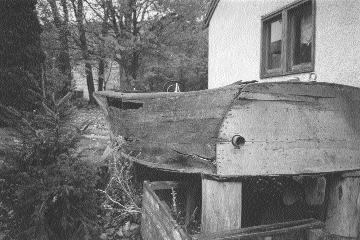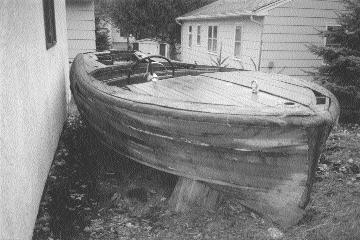by Sherwood Heggen
It is time to consider this question: With regard to a boat needing restoration, how bad is too bad before we should let it return to the earth from whence it came?
Many of you may remember back when a boat was considered to be too far gone when the varnish was coming off the decks and the engine needed a valve and ring job. The attitude was that it would cost more than it was worth to get the boat back into operating condition. You have heard the horror stories from the 50s and 60s of how useable boats were stripped of their hardware and engines and the hulls were either cut up or set afire to get rid of them.
 Today, we are more than happy to get a boat in the condition mentioned above, and pay considerably more than the original purchase price for the privilege of owning it! Are we crazy, or what!? No, we are not crazy. We are just coming from a different perspective than before. The boats that remain are numbered and dwindling because of owner apathy, and lack of money and knowledge/ability to put things back where they belong. So, the remaining hulls become a product of neglect and the effort required to bring them back becomes too great – or so it seems. With that in mind, let me tell you this story of the recent acquisition of my 1948 Chris Craft 17 foot Deluxe Runabout.
Today, we are more than happy to get a boat in the condition mentioned above, and pay considerably more than the original purchase price for the privilege of owning it! Are we crazy, or what!? No, we are not crazy. We are just coming from a different perspective than before. The boats that remain are numbered and dwindling because of owner apathy, and lack of money and knowledge/ability to put things back where they belong. So, the remaining hulls become a product of neglect and the effort required to bring them back becomes too great – or so it seems. With that in mind, let me tell you this story of the recent acquisition of my 1948 Chris Craft 17 foot Deluxe Runabout.
It was a beautiful August day and my wife and I set out to enjoy a day of boating on Prior Lake with another couple who own a 1958 Chris Craft Sportsman. It was planned that we would rendezvous with the owner of a Chris Craft Riviera who also lives on Prior Lake. With the sun shining and a light breeze on the lake, our trip to rendezvous at this other persons house was delightful. We arrived at his dock where his Riviera glimmered in the sunlight. Conversation with this perfect stranger was in high gear in about two minutes because we got right into the subject of our boats. He had done a very nice restoration and was duly proud of it. He mentioned he had another boat needing restoration but really didnt have time to deal with it. He asked me if I would like to see it. As he followed me up to its location by the garage, he was telling me it needed a lot of work, but he had the engine and most of the hardware for it. It was a difficult boat to see because of its barn-wood gray color and stand of weeds around it. I stood there in disbelief. How could anything be so rotten and still stay together?! The aft decks were missing and the hatch was askew over the engine. It had a bad case of what is called hogged which means the once straight sheer line now has a sway-backed nag look to it. The stringers were broken aft of the very rusty engine, contributing greatly to the hogged condition. The bilge was loaded with leaves and dirt and stuff which you wouldnt want to touch without rubber gloves on. The decks were like soft balsa wood, but still had the telltale signs of the grain that at one time gave this boat its character. The sides were splayed due to the hogged condition. The boat had been sitting exposed to the elements for years and it didnt have long left unless someone were to rescue it. This boat was bad. But, was it too bad?
 The owner remarked that he was considering selling the hardware and getting rid of the hull. Wait, I thought. This is a runabout. He cant cut up a runabout! The Deluxe has great lines with its baby barrelback look. Certainly, this man could be reasoned with. I was right, and at a future date we agreed on a price to allow me to be its caretaker. The purchase was made with full intention of a total rebuild. Rebuild?! How can something that bad be rebuilt? Its crooked and rotten! Well, it is a challenge, but lets calm down here a minute and just see what we have.
The owner remarked that he was considering selling the hardware and getting rid of the hull. Wait, I thought. This is a runabout. He cant cut up a runabout! The Deluxe has great lines with its baby barrelback look. Certainly, this man could be reasoned with. I was right, and at a future date we agreed on a price to allow me to be its caretaker. The purchase was made with full intention of a total rebuild. Rebuild?! How can something that bad be rebuilt? Its crooked and rotten! Well, it is a challenge, but lets calm down here a minute and just see what we have.
- Without an original straight line on it, another Deluxe may be needed for some reference measurements. Also, drawings of the same or similar hull are often available. The deteriorated hull itself still tells a lot of the story as to its original shape and dimension. With a little knowledge of stringer shape on which the bottom frames are bolted and transom base shape, you have a good start at putting factory shape back to the hull.
- The transom shape is still there. Knowledge of keel and chine position relative to the stringers is also important for that correct shape. With a straight and sound new foundation, one can continue to rebuild from there.
- The side frames usually dont change in shape or position and can be duplicated in new wood.
- Deck beams may be broken, but they retain their length to indicate the width of the beam. New deck beams can be cut out and properly fastened to the side frames.
- New side and deck planks are easily duplicated by following the frame and batten layout. With some effort, the boat comes back to original condition, albeit, not the original boat.
Granted, this all takes woodworking skill and tools and a lot of new wood, but from the above point of view, this boat is not too bad to be brought back. There are those in our chapter who have brought these basket cases back to life. Ray Ellis has taken his 1942 Century Sea Maid from horrendous, rotted condition to a new boat. Mitch LaPointe has taken his Chris Craft Racing Runabout from a fall-through-the-keel condition to being a real head-turner. My 1938 Chris Craft is 98% new wood. There are 13 remaining of this model intact. Had apathy prevailed, there may be only 12 remaining at this point. If that were to continue, the end result would be none left.
Is it worth it to take one of these basket case boats back from near dead? I guess that all depends. First, what is the boat potentially worth, and second, who is going to do the work? If the boat has great sentimental value or is relatively rare, often cost is no object, that is, if you have the money in the first place. If you do most of or all of the work yourself, there will be a great cost savings since labor is a major expense of any restoration. Another point of view in buying a rough boat is that often they are not much more work than a relatively good boat that needs some wood replacement, but are considerably less expensive in initial purchase cost. Once you start taking things apart in the good boat, its very possible you will find soft bottom frames, chines, keel, and decks which really should be replaced. Also, you will likely find side planks that have cracks, holes, dock gouges, and soft ends. It would be foolish not to replace all of those questionable parts, because sometime in the near future, it will be necessary to go back and fix it right the second time.
Take a look at the pictures of the poor, neglected Deluxe Runabout. Someday you may run across a worthy subject in similar condition. You gotta love it and take it home! Give the poor thing a chance to survive! It may look ugly, but it aint really too bad! Above all, remember:
DONT DESTROY IT; RESTORE IT!

